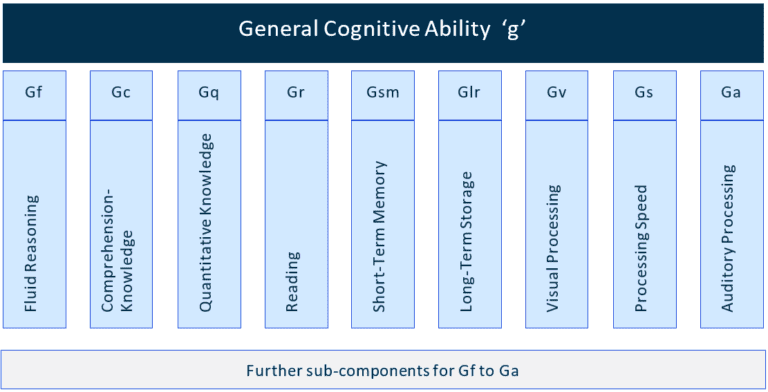It is reported that up to twenty percent of adult learners are neurodiverse. Many are not aware they might have a specific learning difficulty. But what is the science behind testing for learning difficulties?
There is a relationship between overall intelligence, the ability to learn and solve problems, and achievement in academic and formal learning. However, there is a substantial minority who, despite their ability, struggle with formal learning.
Extensive research has been conducted over the past hundred years into the structure of intelligence and cognitive abilities, to understand how people learn and perform at school and in the workplace. Early theories of intelligence suggested a single general factor of intelligence ‘g’ explained the differences between individuals’ abilities. Subsequent research and statistical analysis demonstrated that intelligence can be subdivided into separate but related cognitive abilities, which combine to form an individual’s overall level of cognitive ability.
For the past twenty years, researchers have reached consensus on accepting the Cattel-Horn-Carrol (CHC) model (e.g., Schneider & McGrew, 2012) as an explanation of how different cognitive abilities relate to each other, why people differ across the various abilities, and, importantly, how these relate to academic achievement. It is the underpinning model of human cognitive ability used by educational and school psychologists to identify learning disabilities and difficulties.
The CHC model classifies cognitive ability into three hierarchical strata: stratum III a single “general ability” (or g), stratum II consisting of “broad abilities” and stratum I “narrow abilities” (see diagram).
The following broad abilities show significant correlations with academic achievement skills (e.g. McGill et al, 2018):
- Fluid Reasoning (Gf): the ability to reason and solve problems that often involve unfamiliar information or procedures.
- Quantitative Knowledge (Gq): is the ability to comprehend quantitative concepts and relationships and to manipulate numerical symbols.
- Short-Term Memory (Gsm): the ability to hold information in immediate awareness and then use it within a few seconds, also related to working memory.
- Long-Term Retrieval (Glr): the ability to store information and retrieve it later.
- Visual-Spatial Thinking (Gv): spatial orientation, the ability to analyse and think with visual information, including the ability to hold and manipulate mental images.
- Processing Speed (Gs): the speed and efficiency in performing automatic or very simple cognitive tasks.
- Auditory Processing (Ga): the ability to discriminate, analyse, and synthesise auditory information.
- Comprehension-Knowledge (Gc): the breadth and depth of knowledge including verbal communication and information – otherwise known as crystallised intelligence.
- Reading Ability (Gr): includes basic reading skills.
Additionally, the model includes other broad abilities including:
- Olfactory: ability to detect and process information in odours.
- Tactile: ability to process information from touch sensations.
- Psychomotor: ability to perform body motor functions with precision or strength.
- Kinaesthetic: ability to detect and process information relating to limb position and movement.

The primary cognitive abilities that underpin learning and educational achievement are perception, processing speed, and memory relating to information presented in numerical, verbal, and visual formats. The CHC model is supported by batteries of cognitive tests that can measure a learner’s performance on each of these components.
A formal assessment by a psychologist or special education teacher involves the learner completing a battery of tests. Where a learner underperforms on one or more of the components but has adequate or much higher performance on other cognitive abilities then this is evidence for a specific learning difficulty (SLD). Flanagan et al. (2018) describe the assessment process and criteria in detail. If a learner’s standardised score on a test compared to most people is below 85, then this indicates an SLD.
Aptem Assess is designed to provide a rapid measure of key cognitive abilities that underpin learning and achievement. In a short amount of time, it can highlight learners who may have an underlying specific learning difficulty and require further exploration of their learning support needs.
Learn more about Aptem Assess
For an estimated 80% of learners, the Aptem Assess cognitive assessment will take no more than 15 minutes. Learn more in our short explainer video or our brochure. If you would like to integrate Aptem’s cognitive assessment into your delivery, book a demo, or if you are an Aptem customer, please speak to your Customer Success Manager.
References
Flanagan, D. P., Alfonso, V. C., Costa, M., Palma, K., & Leahy, M. A. (2018). Use of ability tests in the identification of specific learning disabilities within the context of an operational definition. In D. P. Flanagan & E. M. McDonough (Eds.), Contemporary intellectual assessment: Theories, tests, and issues (4th ed., pp. 608–642). The Guilford Press.
Flanagan, D. P., Ortiz, S. O., & Alfonso, V. C. (2007). Essentials of cross-battery assessment. (2nd Edition). New Jersey: John Wiley & Sons, Inc
McGill, R. J., Dombrowski, S. C., & Canivez, G. L. (2018). Cognitive profile analysis in school psychology: History, issues, and continued concerns. Journal of school psychology, 71, 108-121.
Schneider, W. J., & McGrew, K. S. (2012). The Cattell-Horn-Carroll model of intelligence. In D. P. Flanagan & P. L. Harrison (Eds.), Contemporary intellectual assessment: Theories, tests, and issues (3rd ed., pp. 99–144). The Guilford Press.
Schneider, W. J., & McGrew, K. S. (2018). The Cattell-Horn-Carroll theory of cognitive abilities. Contemporary intellectual assessment: Theories, tests, and issues 4th Ed, 73-163.

